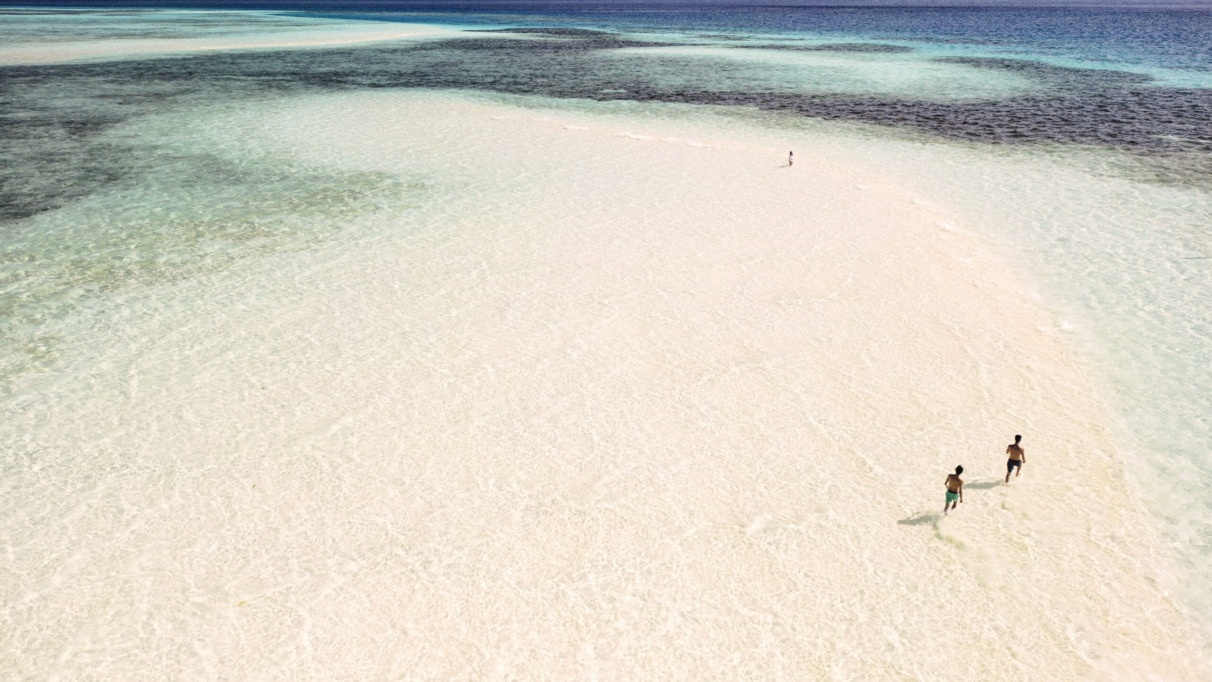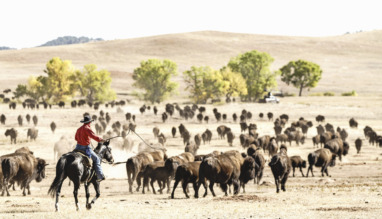Travel Story: a Journey to the Philippines’ Last Frontier
Amid the South China Sea and Sulu Sea lie tropical islands renowned for their pristine nature and marine biodiversity, often called “The Last Frontier” of the Philippines. How far south can we make it?
My backside feels bruised with every jarring drop, and my clothes are soaked. Each unavoidable spray of water following a wave sends flippers and sandals tumbling at our feet. I feel like a crash test dummy, tossed around inside the wooden frame of the bangka—the traditional Filipino outrigger boat whose name now strikes me as hilariously ironic.
I’d love to share my thoughts with my companions—photographer Malou, guide Renz, and a nameless hitchhiker—but that’s impossible. The twin diesel engines, where Captain Alex sits (also the owner of the Lex Ter Ann), roar so loudly that any attempt at conversation is drowned out. Alex, unfazed, pulls another cigarette from his half-soaked pack. Calmly, he leans his elbow on the jerrycan beside him, where two greasy hoses feed fuel to the engines. I can only hope OSHA isn’t reading this.
Why would anyone voluntarily endure such hardships? To feel like they’re journeying to a piece of Earth still undiscovered. A place that isn’t marked in red on world maps, where getting there takes effort.
For us, that place is the 1,780 tropical islands of Palawan province, in the southwestern Philippines—a final stronghold of untouched wilderness, limestone cliffs, coral reefs, powdery white beaches, native wildlife, and coastal communities that rely on the sea. We’ve set a goal for ourselves: to travel as far south as possible, to the very tip of this last bastion.
Our Own Robinson Crusoe
But let’s start at the beginning. Five days earlier and 470 miles farther north, in the northern part of the province. Before we attempt to sail off the world map, we explore the islands of the South China Sea. We cruise past the islands of Coron and along the western coast of Busuanga in a similar bangka, though this time, thankfully, the diesel engines are safely tucked away in a proper engine room.We share the boat with a handful of crew members and other adventure-seekers: a paramedic, a jiu-jitsu instructor, an accountant, a psychologist and his girlfriend, who’s into yoga. I can’t help but think, if we were to be stranded on an island like castaways, at least we wouldn’t have to worry about survival. For my part, I brought along a brand-new Leatherman multitool specifically for this island expedition. It includes a knife, saw, pliers, hammer, can opener, screwdriver, fire starter, sharpening stone, and even a whistle.
The 1,780 tropical islands of Palawan province are one of the last bastions of pristine nature.
So far, our journey across the South China Sea is smooth sailing. Every hour or so—sometimes a bit longer, sometimes shorter—the captain cuts the engine, giving the crew time to drop anchor and the passengers a chance to slip on their flippers. At each new tropical island we visit—Lusong Coral Garden, South Cay, Maltatayoc Sand Bar, and many others—the same ritual unfolds: arms and legs are slathered in sunscreen, goggles are soaped up, and phones are secured in waterproof cases. By the time the frogmen leap into the water from the outrigger’s left side, Malou and the paramedic are already launching their drones into the sky.
I linger a little longer to take it all in. I gaze at the palm trees that separate the white sands from the dark limestone cliffs, the turquoise water so clear you can see straight through it, and I reflect on how timeless this view is. Thousands of years ago, someone else—different yet the same—must have looked at the very same scene. That theory holds up. In the 1960s, anthropologists discovered human remains in the Tabon Caves on the mainland of Palawan, evidence that these lands have been home to indigenous peoples for millennia.
When we reach Black Island—named for its towering dark rocks—I plunge into the tepid water and follow the accountant-turned-certified-diver’s flippers toward the shore. Amid a shimmering school of anchovies, we swim over the coral reef, skimming past the skeleton of an old shipwreck. On the beach, Nat, one of the crew members, is already waiting for us by an opening in the rock wall.
The gap leads to a dark, cavernous grotto where freshwater drips from the stalactites above, mixing with a mysterious seawater pool. “Do you see the mermaid across the way?” Nat gestures toward a stalactite formation where you can indeed make out the shape of a tail, torso, and face. “The indigenous Tagbanwa people, who have guarded these islands for thousands of years, still perform rituals here. They believe they share the islands with mythical beings who offer them protection.”
Three Days Without a Care
For three days, it feels like nothing exists but our old outrigger fishing boat and the vast expanse of the South China Sea. We spend so many hours underwater, gliding over coral reefs and Japanese shipwrecks from World War II, that even when we close our eyes, we still see fish swimming by: parrotfish, clownfish, lionfish, pufferfish, pipefish, wrasse. Round. Flat. Elongated. But always brightly colored.
It’s indescribable—a calm washes over us like nothing we’ve ever experienced. It’s as though a filter has swept away all unnecessary thoughts. We simply notice the islands we pass, watch clouds morph into fantastical shapes, and wave to the locals in their fishing boats—free from intrusive musings.
All it takes to explore the islands of Palawan is a simple, old outrigger fishing boat.
I decide to read a book on the upper deck. My choices are limited. The only book about Palawan I could download for free to my e-reader is about the endemic Palawan peacock-pheasant. Its title sums it up pretty well: The Palawan Peacock-Pheasant Care Guide: Insights on Maintenance, Breeding Tips, Nesting Behavior, Communication, Health Issues and Prevention, Importance, Threats, and Much More.
“The chances of seeing one here,” says Jerome, Nat’s brother and a crew member who’s peering over my shoulder, “aren’t great. They mostly live in the rainforests of Palawan’s interior.”
Back at the base camp on Debotunay Island, a cool breeze carries the soapy scent of plumeria flowers past the huts. I decide to try my luck. Following a narrow path of rustling leaves from the island warden’s hut, I venture into the jungle in search of the peacock-pheasant—or any other impressive jungle creature. But apart from some rustling in the bushes, I find nothing. Not even a mosquito bites my calves, which I find pleasantly surprising.
Instead, I spot an array of plants near the huts and in the forest beyond: caladiums, monsteras, philodendrons, hibiscuses, and begonias. All those hours I spent as a kid in gardening centers with my mom are finally paying off. And for anything I don’t recognize, my plant identification app can fill in the blanks.
Emerging from the forest later on the other side of the island, I see the psychologist standing in the surf, his arms around the yoga instructor’s neck. I immediately share my discovery, tossing a fruit into the water with a wide arc. “Look, a noni! Smell it—it’s awful!”
Later that evening, as the sun sets, the psychologist proposes to his girlfriend. For a moment, I panic. Did I accidentally ruin an earlier proposal with a sticky fruit that, according to my app, smells like vomit?
Mysterious Coron Island is undoubtedly one of the most beautiful places on earth.
The Myth of the Giant Octopus
We have one last island to check off our northern Palawan itinerary: Coron Island. From a distance, the island looks even more menacing than Black Island. Towering limestone formations, cloaked in green, rise hundreds of feet out of the sea like a colossal monster. Behind these cliffs lie crystal-clear lakes—such as Kayangan and Twin Lakes—considered among the most beautiful spots in all of Palawan. But such popularity comes with a downside: nowhere else on this expedition will we encounter as many tourist boats. The wooden walkways built along the steep cliffs are crowded with so many orange life jackets, it feels like a Dutch soccer match is in full swing.
“Not all of Coron Island is open to tourists,” Jerome explains. “Some areas are considered sacred by the Tagbanwa people. In the center of the island is a dark lake, avoided even by them. They believe a mythical creature lives in the shadowy water—a being that is part human, part octopus, and not fond of intruders. Even when they’re granted permission by the tribal leader to enter the area, perhaps to harvest bird nests—a delicacy in parts of Asia—they proceed with the utmost caution. The ‘Giant Octopus,’ they say, could easily drag you into the depths with its tentacles.”
The Final Stretch of the Last Frontier
Back to the place where, in theory, everything could have gone disastrously wrong—hundreds of miles farther south. We’re a tiny, noisy speck on the turquoise Sulu Sea, on a day as blistering hot as every other.
To the left, to the right, ahead, behind, and every few seconds above us—nothing but water. Well, occasionally flying fish, skimming the surface like flattened skipping stones. For hours, we watch a barren horizon, until Alex changes course and, with his cigarette still clamped between his teeth, shouts, “Land ahoy!”
The diesel engines fall silent, but by the time we reach Onok Island—one of the most stunning islands in the Philippines—most of the birds have already fled. Or perhaps they’ve suffered severe hearing damage. Since we set out early that morning, we’re the first to arrive at this dreamy strip of land in the middle of the sea. An almost incomprehensible silence greets us. Through the swaying palms, we take in the entire length of the island: one end boasts a pier with a vacation house; at the other, a few huts house the coast guard’s stash of dried fish in nets, a hammock sways lazily in the breeze, and coconuts lie scattered on the ground.
Downtime on Onok Island.
“The sandbank to the left of the pier,” Renz says, “is the best spot to see turtles.” From barely six feet away, I watch as four equally sized turtles nibble slender blades of seagrass from the seabed. I float gently, carried by the ebb and flow of the sea, almost feeling like one of them. But the peaceful spectacle doesn’t last long. A stray wave sends a gulp of saltwater through my snorkel, and my sputtering startles the turtles, sending them darting into the depths.
Still content, I lift my head above water. With a satisfying pop, I push my mask onto my forehead and notice that six more outrigger boats are now moored along the shoreline. At that moment, with a deafening roar, a helicopter lands in the center of Onok Island.
“The Governor,” Renz explains, quickly ushering me off the pier. “The owner of the island.” Surrounded by coast guard security, the famed politician strides toward his house on the pier, drawing stares from half-clad tourists wearing snorkels.
“As a visitor, you can still come to the island,” Renz assures me. “But during his presence, the pier is off-limits. And overnight stays are no longer allowed.”
Life on the Sulu Sea
After each day trip through the Balabac Islands, we return to our base camp on Sicsican. It’s a pleasant, modestly sized island with rows of straight palm trees where Man-Man and his father, the island’s owner, run a small shop. The selection is simple but sufficient: toilet paper, coconuts, water, imitation Oreos, rum, and liter bottles of beer. “This island came into our family’s possession thanks to my great-grandfather,” Man-Man explains. “He was a woodcutter and bought the island in the 19th century from the indigenous people, who were too afraid to live here because of pirates on the Sulu Sea. He paid about 25 euros, or 1,500 pesos. He never lived here himself, but it seems he foresaw the island’s future purpose—sharing its beauty with visitors.”
Sailing among the islands of the Philippines’ final frontier, we gain a deeper understanding of life in this remote region. We watch locals searching for mud crabs in the tangled mangroves, navigate past pearl divers and seaweed farms, and chat with traders and fishermen who remain vigilant against the freshwater crocodiles lurking in the deep waters around Balabac Island.
At a strategic point between the islands, Serena runs a shop perched on stilts high above the water. Most of her customers are sailors, who climb a ladder to her store to buy spark plugs or engine oil repurposed in old Coca-Cola bottles. “Every morning,” Serena says, “a six-meter-long freshwater crocodile swims between the stilts of our house. That’s exactly why I don’t let my son swim here. But as long as I leave the crocodile alone, it leaves me alone. Sometimes I see it sleeping on the beach out back, or occasionally snatching a dog or a monkey.”




